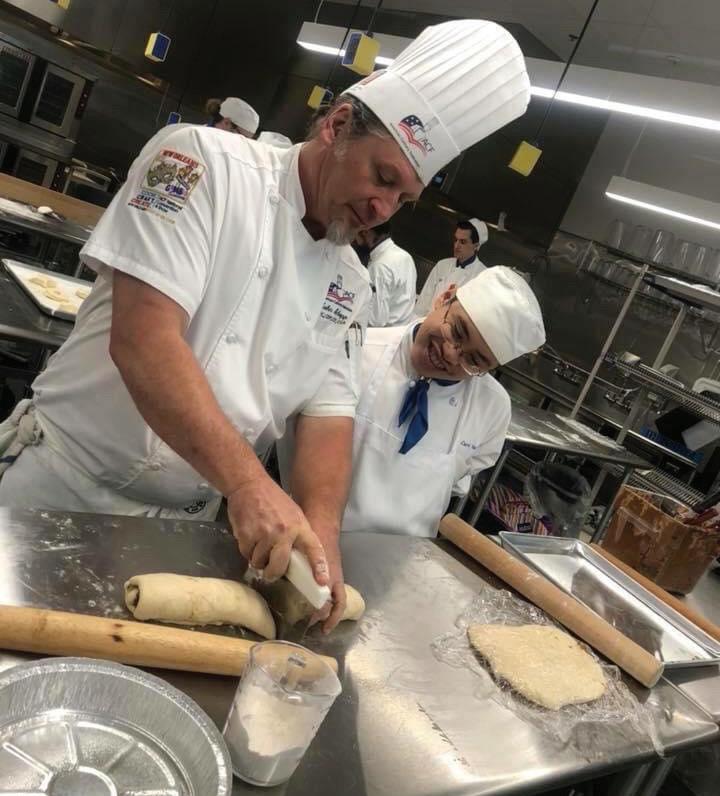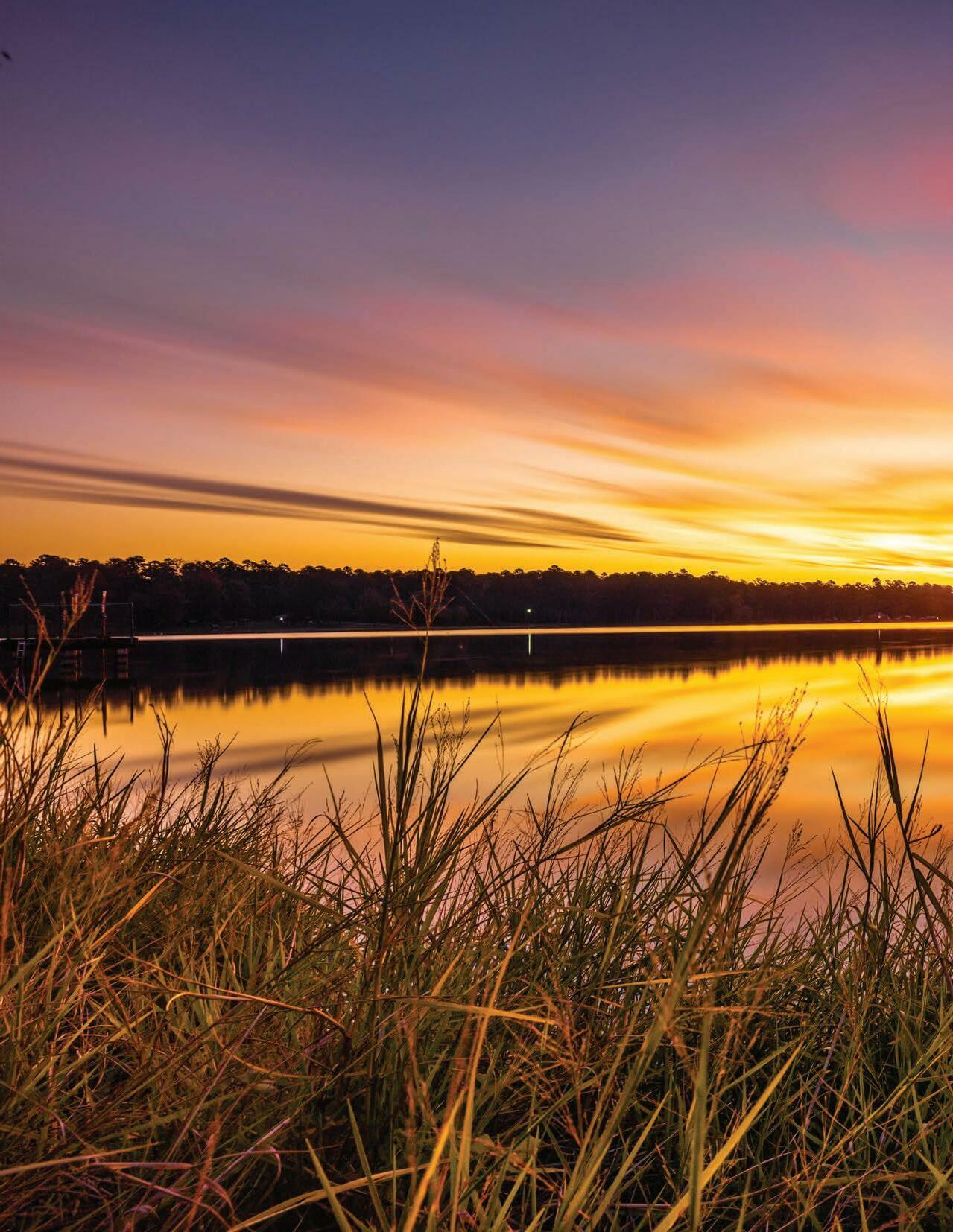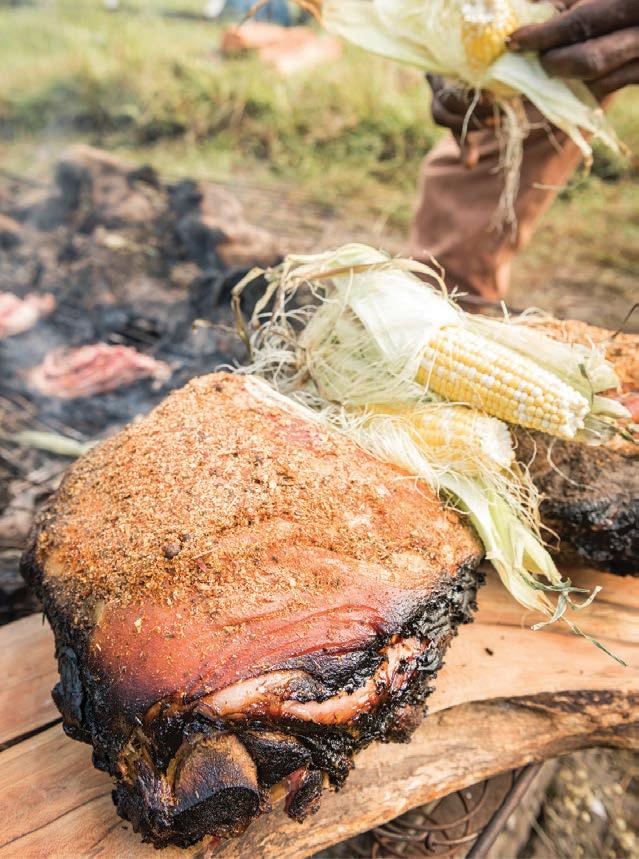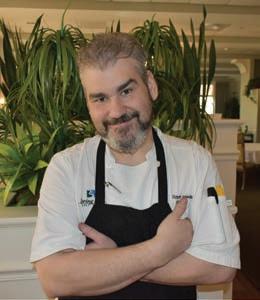
14 minute read
Segment Spotlight
from National Culinary Review (Nov/Dec 2021)
by National Culinary Review (an American Culinary Federation publication)
Blue Skies Ahead
Independent restaurant operators are hopeful about the business climate, despite crippling challenges in the past year // By Amanda Baltazar
Catering constitutes about half of the revenue at The Cook and The Cork in Coral Springs, Florida. So when COVID-19 arrived, the impact was even more devastating to that side of the business for owner Chef Keith
Blauschild, CEC
(top), than to the main restaurant operation. However, he’s hopeful that whenever this pandemic is over, his catering customers will come out en masse and book bigger and more lavish events to make up for lost time. Chef Blauschild also expects his restaurant business to see bigger spenders, in part through necessity — food prices and labor costs are up — and in part because many diners, tired of cooking and eating at home night after night, will be more likely to splash out. Chef Blauschild is not alone. After many bleak months, other independent restaurant operators are cautiously optimistic about the future.
Chef Sam Hart (bottom) has a different story than most. He opened his restaurant, Counter-, in Charlotte, North Carolina, in September 2021 and had plenty of qualified labor to choose from as many chefs and cooks had recently been laid off from other restaurants.
Counter- is a ticketed restaurant offering orchestrated meals that pair food with music. Business is going so well that Chef Hart is planning to move to a larger operation in early 2022 and open a second concept.

Lingering Labor Issues
Operators are being creative to combat the current shortage of labor.
Chef Blauschild is hiring more highly qualified employees for entry-level jobs. This means he pays the employees more and, subsequently, is raising menu prices slightly. He’s offering health insurance benefits and looking for employees who want to move ahead, “if not with our company then to run their own kitchen some day.”
Chef Rena Frost (below) is the owner of ReWard Restaurant Group in Grapevine, Texas, which includes two restaurants, Mac’s on Main and Mac’s Bar & Grill. She has implemented a hiring bonus: Current employees who recommend a new hire receive $300, and new staff members receive $500.
She’s considering keeping this perk even when the labor market looks up. “The incentive works,” she says. “If it helps someone out, and it’s a safety net between bills, it’s worth it. I don’t see it going away this year, and it might be the way we do things now.”
Chef Frost has also sped up training from five days to four to get new hires on to the restaurant floor. She has mostly dropped POS training and wine and alcohol education, opting instead to do the latter as a pre-shift.







Clockwise from upper left: Brunch dishes at Mac’s on Main; shots from the restaurant’s main dining room; burrata, shrimp tamales and Korean short ribs by Mac’s Chef Rena Frost.
To keep the staff he’s hired, Chef Hart has a simple tactic — he pays them all superlatively. “Our lowest makes over $35,000 with four weeks of vacation and benefits,” he says. “We’re trying to make it a more livable and workable environment. When staff are paid accordingly, guests will pay the extra $1 or $2.”
Positive Business Changes
Chef Blauschild has been forced to make changes to his business due to COVID-19 but thinks many of these changes may stay. Last year he added outdoor dining, and those 24 seats help boost revenue, he says.
Because sourcing became so difficult in the early days of the pandemic, chefs were forced to source more locally, Chef Hart says. More than 50% of meat and 60% of produce for Counter- comes from North Carolina.
He works with a Charlotte company, Freshlist, which “does the dirty work and finds the farmers and creates a distributor for all these farmers — which redistributes food out to chefs,” he says.


A dish by Chef Sam Hart, owner of Counter- in Charlotte, North Carolina (left); The main dining room at The Cook and the Cork in Coral Springs, Florida (right).
This costs him 30% more than if he were dealing with the farmers himself. “I can communicate directly with these farmers; it’s much more personal, and you can count on it much more.”
The pandemic has also paved the way for smaller restaurants like his, which is just 18 seats, as consumers want to reduce their exposure to other people. “The 150-seat restaurant is dead,” Chef Hart says.
Chef Americo DiFronzo, CEC, CCA,
AAC (left), executive chef at the historic Union Oyster House in Boston, says the supply chain is still suffering and “it’s a challenge purchasing items we need.” This is due to both employee and product shortages, he says. “In the past, I would order week to week. Now I need to carry more inventory to stay ahead [and] have enough product to operate.”
Another big change for Chef DiFronzo was that Union Oyster House last year offered outdoor seating for the first time in its 195-year history. “That was a positive because the alfresco dining scene in Boston wasn’t that strong,” he says. The restaurant placed tables on the sidewalk, together with other cafes on the street, so, he says, “it looks beautiful with the different colored umbrellas and designs.” He’s hoping this will become a permanent fixture.

Menu Matters
Due to both the labor shortage and high food costs, chefs have been making significant changes to their menus.
Chef Blauschild took high-labor dishes off his menu. His house-made potato pierogies are gone, replaced by burrata cheese with grilled peaches and a balsamic glaze, which, he says, “is a higher food cost but hardly any labor.” Eventually some higher labor items will come back, he says, “if there is still customer demand and we can produce it.”
Chef Frost also shrank her menu, by about 20%, to keep the pressure off her chefs and to order less inventory. She realized some menu items didn’t translate well to takeout, such as dishes with delicate sauces like shrimp with a beurre blanc or those that would steam in the to-go containers.
In addition, she removed some items due to high costs like crab cakes, several steak items and a lamb burger dinner.
Chef DiFronzo also scaled back his menu, removing about 20% of items for several reasons. “We didn’t have sufficient labor to work all of the previous stations, nor enough guests, and because the menus, which became paper and disposable, went down to one page,” he says.
After an incredibly difficult 18 months, chefs are finding positives as we stumble through what’s hopefully the end of this pandemic.
“People want restaurants; they went out of their way to show us that,” Chef Frost says. “I’m very optimistic.”
Amanda Baltazar is a Pacific Northwest-based writer who covers food, beverages, restaurants and retail and is excited to see independent restaurants get back on their feet.
SPRINGING INTO ACTION
Considerations and steps to take for a successful volunteer effort in a disaster // By Amy Sins
When Hurricane Ida was about to hit — in the middle of a pandemic, no less — I feared for the worst. My brain shifted immediately to my Hurricane Katrina experience when I lost my home, and my heart sank. Born in New Orleans and raised in southern Louisiana, I’m no stranger to hurricane season. I’ve been through more than I can count.
Hurricane Ida was a tough one. She came in fast, was much more powerful than anticipated and wreaked havoc on southeast Louisiana. The damage was significant: Homes and businesses were destroyed, and our power grid was devastated.
I reached out immediately to my employees and chef friends to see how they fared. The responses ranged from minor roof damage to the loss of hundreds of pounds of meat and seafood that one of my friends purchased for her restaurant — that had just opened. Another dear friend completely lost her home and everything in it. Relatively speaking, this was not another Katrina because no levees broke. But it was still important to spring into action to help others find safe shelter, water and food.
Chefs naturally want to help when disaster strikes by running to the scene to get to cooking and feeding. That is nothing short of noble or heartfelt. Feeding people is what we do. But after working through so many disasters, I have learned that on-site cooking is one of the last things that actually happens in the weeks following a natural disaster. Sadly, there will always be disasters in our future, so allow me to share with you some of what I have learned so that you can be prepared to jump in with both feet and make an immediate impact in your community.
Safety is No. 1. In the hierarchy of needs, making sure everyone is safe is the No. 1 priority during and after a disaster. That means assessing any injuries and seeking treatment, as well as making sure people have a safe place to sleep at night.
Oftentimes, I get calls from chefs who right away want to help out and cook food. I wish we could logistically make that happen, but too many things work against such efforts in the immediate days after a disaster. Often, there is no running water, limited or no power, no refrigeration and even dangerous conditions that can make it difficult to go from point A to point B. Trees are down, power lines are live, and entire communities may be flooded. People are being evacuated to safe locations, and that could change hourly. You showing up unannounced in a disaster zone that is still in triage may sadly hurt more than help. You could be in danger, you could put others in danger, and you may take valuable resources away from people in need.
Water, water, water. Nine times out of 10, the first thing people ask for and need immediately following a disaster is water. Water is always in short supply, and shelves are bare. We’ve had the most success purchasing 18-wheelers of water and having that water trucked into areas where it can be distributed. Waiting for the standard supply chain can take weeks.
Once that need is met or partially met, we start to move on to food, particularly nonperishables. Consider the fact that most people don’t have running water. Cleaning their hands is tough, so you don’t want people touching too much food. Choose wrapped items that don’t need to be cooked or refrigerated and are healthy, high in calories and protein-rich — simple things like granola bars or nut bars with protein and fat, as well as shelf-stable protein drinks. Don’t forget about shelfstable fruit cups.
Connect with people on the ground who you can
trust. I cannot stress this enough! There are a lot of shady people and organizations out there, and disasters can be full of misinformation. Accurate intel, boots on the ground and people who you trust are key to success in any disaster relief mission. For me, this is about building a network, whether that’s through churches, volunteer groups or even small-town government officials. I find partners who have the right priorities in place, along with some experience working disaster relief. We work as a team to determine the needs in impacted areas. Local contacts are best: They understand the community and are deeply ingrained in it.
The most efficient way to safely feed large groups of people after a disaster is to connect with a community organization or company that has a commercial kitchen, preferably in an area not directly impacted by the disaster and try to process as much food there as possible. Trained chefs put out exponentially more food than a group of volunteers with a chef manager. I partner with Second Harvest Food Bank, Mercy Chefs and Culture Aid NOLA because they are trustworthy and reliable partners. They have volunteers and huge commercial kitchens with backup systems and are part of our regional disaster relief network.
Food safety is crucial, especially during a natural disaster.
During a natural disaster, hospitals are often shut down or hard to get to because of dangerous conditions, so the last thing we want to do is make people sick. We have found the most efficient and safe way to produce food is to create boil-in-a-bag meals. To do this, a group of trained professional chefs and I will prepare the meals at a central commercial kitchen. Or in the case of the 2016 flood, ask restaurants to prepare the meals in their kitchen.
Once the food is cooled or blast-chilled and bagged, it can be frozen for transport. We recommend bagging in 10-serving packages or up to 100 servings a bag depending on the restaurant’s capability. This then allows us to safely transport the food, without the need for ice, to a response team on the ground. We often send these bags to police stations, fire stations and local churches. Here in southern Louisiana, everyone has a giant crawfish boil pot or two and propane tanks. Now, any community hub can safely boil food in a bag, heat it to the required temperature and serve a meal without compromising the product or contaminating it. The health department will still come out and do an inspection if you’re running a cooking operation, even in the middle of a disaster. ALWAYS mind your temperatures and have thermometers at the ready everywhere.
Be creative, but not too creative. Everyone wants to know what we cook when we are able to cook. We cook GOOD FOOD. Just because you’re hungry, just because you’re dealing with a disaster, does not mean you do not deserve a delicious and beautiful meal. If it reheats well, the sky’s the limit. Favorites include New Orleans red beans and rice, chicken and andouille gumbo and crawfish and corn bisque. The No. 1 item people love are our grillades and grits. I personally love our okra and tomato stew and broccoli-and-cheese rice. It’s important to keep in mind that not everyone eats meat. We try to incorporate vegetables as much as possible and balance the nutrition where we can with the donations we have. Did I mention red beans and rice? SO MUCH RED BEANS AND RICE.
At the same time, it’s important to know your audience. I once had a Vietnamese restaurant offer to donate a bunch of banh mi sandwiches. Not everyone in Louisiana has been exposed to a variety of international flavors. A disaster when people are hungry and want the familiar is not necessarily the time to broaden their palates. In that situation, we ended up finding a church with a diverse population that had been exposed to a variety of different foods; the congregation was ecstatic not to have to eat more red beans and rice. Again, people on the ground who you trust and who know the community are key.
Label anything and everything. Just because there’s a disaster doesn’t mean food allergies no longer exist. That’s why it’s important when cooking for others to label everything with the date produced, location produced and any allergens that may be present. People on-site laugh that I label the labels. There is blue tape everywhere and sharpies within reach at all times. Consider the fact that if you’re running a relief mission you have volunteers who have never cooked in a kitchen, volunteers who don’t know where to look for items and the occasional volunteer who doesn’t know that raw chicken does not go in the same ice chest as lettuce. Labeling everything — the ice chests, the tables, the cutting boards, the clean/dirty bin, the handwashing sink — keeps things organized and minimizes the need for you to answer questions during chaotic times. If everything is labeled, when a volunteer shows up, your orientation time is cut down significantly.
As chefs, we all want to cook, but during a disaster there are sometimes better ways we can truly step up and make an impact. Our knowledge of food safety, the way we manage stressful situations and complex personalities, our understanding of the brigade system and our ability to handle logistics while making difficult decisions all make us successful leaders during a disaster. This article has been condensed for space. To read the full story, visit WeAreChefs.com.

A New Orleans-born Louisiana native, Chef Amy Sins is an award-winning cookbook author, radio host, media personality, former restaurant owner and founder of Langlois, a culinary event business for private gatherings, international travel tours and business conferences. She has played many roles over the course of her 20-plus-year professional journey, including that of “girl with a cellphone” who has developed a template for quick and effective disaster relief. Follow her on Instagram @chefamysins.







